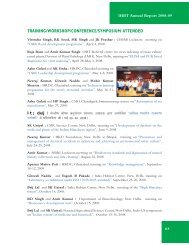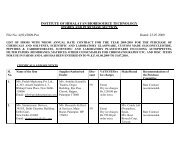Create successful ePaper yourself
Turn your PDF publications into a flip-book with our unique Google optimized e-Paper software.
CSIR-<strong>IHBT</strong> <strong>Annual</strong> <strong>Report</strong> 2010-11BLACK CARROT (Daucus carotassp. sativus)Four anthocyanins (1-4) were isolated andcharacterized (Fig. 18). Their amountswere determined as 2>4>3>1 in freshplant materials by HPLC. In addition, invitro DPPH radical-scavenging activity ofthe extract and isolated compounds weredetermined.RHODODENDRON (Rhododendron spp.)Fig. 18 Chemical structures of anthocyaninsA rapid and sensitive RP-HPTLC method was developed for the simultaneous determination offour bioactive phenolics viz., epicatechin, syringic acid, quercetin-3-O-galactoside and quercitrinin the leaves of R. arboreum, R. campanulatum and R. anthopogon (Fig. 19).Rhododendron anthopogonFig. 19 RP-HPTLC analysis of rhododendron phenolicsVolatile constituents of the hydrodistilled (HD) and supercritical–CO 2extracted (SC-CO 2) oilwere compared with headspace analysis (HS). A total of 27, 31 and 17 constituents were identifiedin SC-CO 2, HD and HS, respectively. The key compounds identified were p-menthadiene-2,9,diol(7.28%), β-caryophyllene (5.96%) and α-humulene (4.06%) in SC-CO 2whereas, β–caryophyllene(11.62%), limonene (11.26%), α-humulene (7.22%) and E-nerolidol (5.83%) dominated the HDoil. In HS analysis, γ-terpinene (40.73%), limonene (24.14%), β–ocimene (7.15%), α-terpinene(4.92%) and β–phellandrene (3.44%) were the major constituents.WALNUT (Juglans regia)Methanolic extract and its n-hexane, chloroform, ethyl acetate and n-butanol fractions from barkwere investigated for total phenolic content and in vitro antioxidant activities. Highest activitywas observed in ethyl acetate fraction which was comparable to synthetic antioxidant butylatedhydroxy toluene (Table 4). In an another study, a simple, reliable and validated RP-HPTLCmethod was developed for the simultaneous quantification of gallic acid, caffeic acid, quercetin,rutin, myricetin and juglone in the extract/fractions (Fig. 20). These were also evaluated forthe color properties in terms of brightness (L), hue (h) and chroma (C) (Table 5). The resultsindicated that the phenolic rich fractions, especially ethyl acetate, might find use as a naturalantioxidant and/or colorant.21




